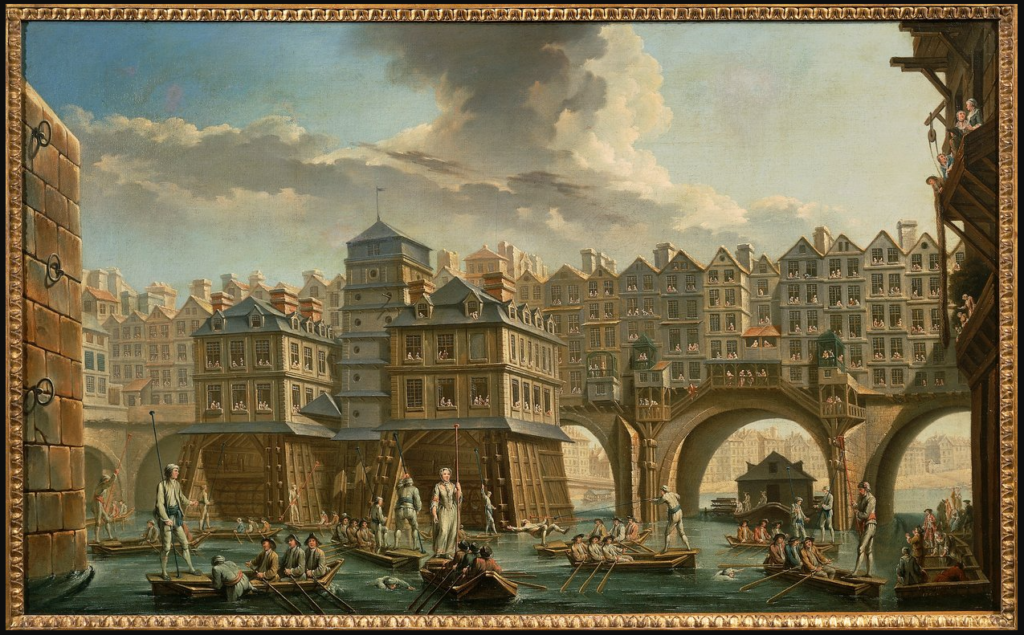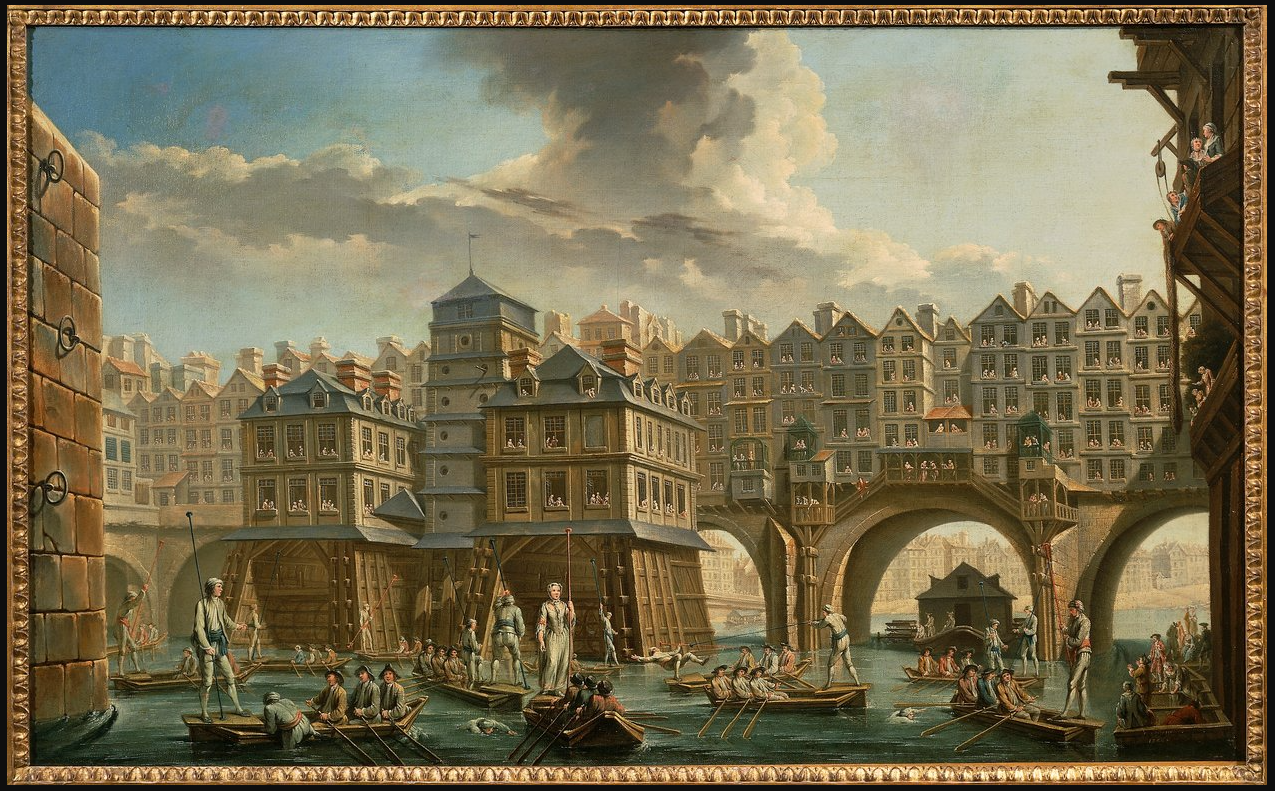In medieval Paris, bridges were more than simple river crossings — they were thriving urban centers. These structures not only connected the city’s banks but also supported rows of houses, shops, and workshops, creating vibrant neighborhoods suspended above the Seine.
With Paris constrained by fortified walls and limited space, the need for expansion drove innovative solutions. Bridges provided the perfect opportunity for growth, blending infrastructure and residential life. By the 12th century, Parisians began constructing buildings directly on bridges, transforming them into bustling streets over water.
Pont Notre-Dame — A Bridge of Wonders and Tragedies
The Pont Notre-Dame stood as one of the grandest architectural marvels of medieval Paris, a symbol of both urban progress and human vulnerability. Its history was marked by stunning ingenuity and catastrophic misfortune. Originally constructed in 1507 under the reign of Louis XII, the bridge replaced an earlier structure that had tragically collapsed in 1499, sending dozens of people and their belongings into the unforgiving waters of the Seine.
To avoid repeating past mistakes, the new Pont Notre-Dame was built with remarkable precision and care. This bridge was one of the first in Paris to be designed with a unified architectural style. Rows of elegant, timber-framed houses lined both sides of the bridge, their façades carefully aligned and their heights standardized to give a harmonious, almost regal appearance. Each building featured two stories, with shops and workshops on the ground floors and residences above.

The bridge soon became a bustling thoroughfare, vibrant with life and commerce. Bakers, cloth merchants, and artisans set up shop, drawing Parisians and travelers alike. Goods spilled from the stalls onto the narrow street, and the scent of freshly baked bread mingled with the smoke from ironworkers’ forges. Shouts of merchants and the clatter of carts on cobblestones filled the air, while pedestrians squeezed past each other on the bridge’s congested pathway.
Yet the Pont Notre-Dame bore a hidden fragility. Fires, a constant threat in the tightly packed medieval city, proved devastating. In 1621, a blaze swept through the bridge, devouring many of the wooden structures. Though rebuilt, the weight of the buildings continued to strain the stone arches beneath. The ever-present risk of collapse loomed over the heads of residents and traders.

By the late 18th century, concerns over safety and river traffic grew. The densely built bridge hindered the flow of boats along the Seine. In 1786, the city authorities decided to demolish the houses that adorned the Pont Notre-Dame, stripping it back to a simple, functional crossing.
Though its buildings are long gone, the Pont Notre-Dame lives on in the imagination as a vivid reminder of medieval Paris — a place of beauty and peril, innovation and disaster. It was a bridge that encapsulated the spirit of a growing city, forever balancing between wonder and tragedy.
Pont-au-Change — The Center of Trade
The Pont-au-Change, or Money Changers’ Bridge, was a vital artery of medieval Parisian commerce, where the hum of trade resonated above the waters of the Seine. Originally constructed in the 12th century, this bridge was aptly named for the money changers and financiers who conducted their business along its length. In a city bustling with merchants, pilgrims, and travelers, this bridge was a critical hub where currency from all corners of Europe exchanged hands.
Flanked by rows of timber-framed buildings, the Pont-au-Change was far more than a river crossing. The ground floors of these tightly packed structures were alive with activity. Money changers, seated behind counters piled with coins of gold and silver, set their exchange rates and weighed precious metals with meticulous precision. Jewelers and goldsmiths showcased intricate pieces, their glittering displays drawing the eyes of nobles and commoners alike. The scent of molten metal mingled with the sharper tang of ink and parchment used by scribes, who documented transactions and legal contracts.

Above the shops, families lived in compact dwellings, their upper stories leaning over the bridge as if straining for space. Windowsills overflowed with laundry and flower pots, adding a touch of domestic charm to this hive of commerce. The narrow street between the buildings buzzed with the ceaseless movement of traders, horses, and carts. It was a place where fortunes were made, debts were settled, and the air thrummed with ambition and the clink of coins.
Despite its economic importance, the Pont-au-Change was not without peril. Fires frequently threatened its wooden buildings. One of the most devastating incidents occurred in 1621, when a blaze swept through the bridge, destroying many of the shops and homes. The bridge was rebuilt with stone arches, but the ever-present risk of catastrophe loomed over the traders and residents who worked and lived there.

By the late 18th century, the demands of a modernizing city led to the clearing of buildings from the bridge. The once-bustling market above the Seine was transformed back into a functional crossing, stripped of its former vibrancy.
Today, the Pont-au-Change remains, albeit in a much-altered form, connecting the Île de la Cité to the right bank of Paris. While its wooden houses and money-changing stalls have vanished, its legacy as a thriving center of medieval trade endures. The bridge stands as a testament to a time when commerce and community flourished above the flowing waters, and the heartbeat of Parisian trade echoed over the Seine.
Pont Marie — The Bridge of the Island
The Pont Marie, completed in 1635, is one of Paris’s most charming and historically rich bridges, a vital link connecting the Île Saint-Louis to the Right Bank. Named after its engineer, Christophe Marie, this bridge was conceived during a time of ambitious urban development, when the Île Saint-Louis was being transformed from a swampy, uninhabited landmass into a fashionable residential district.
What set the Pont Marie apart was its dual function as both a bridge and a neighborhood. Nearly 50 houses and shops were built atop its sturdy stone arches, creating the impression that the Île Saint-Louis extended directly over the waters of the Seine. The buildings, constructed primarily of timber and stone, were tightly clustered, with their upper floors leaning slightly over the bridge’s narrow roadway. Merchants and artisans occupied the ground floors, selling everything from baked goods and cloth to tools and trinkets. Above them, families lived in cramped but lively apartments, enjoying the unique privilege of residing above one of Paris’s most scenic waterways.

The bridge bustled with daily life. Residents leaned out of windows to exchange gossip or hang laundry, while shoppers jostled for space amid the wares spilling from market stalls. The soft murmur of conversations and the clip-clop of horses blended with the sounds of the river below. It was a place where the boundaries between public and private life blurred, and the hum of human activity seemed to echo over the Seine itself.
Yet this idyllic vision was not without its dangers. The Seine could be unpredictable, and the bridge’s wooden structures were vulnerable to fire and flooding. In 1658, a catastrophic flood struck Paris. The surging waters collapsed two of the bridge’s arches, sweeping away several buildings and their occupants. The tragedy served as a harsh reminder of the risks of living over a river. Despite this, the Pont Marie was repaired and continued to serve the city, though the destroyed houses were never rebuilt.
By the late 18th century, as with many other inhabited bridges in Paris, concerns over safety and urban congestion led to the decision to clear buildings from the Pont Marie. The bridge was eventually stripped of its homes and shops, returning to a simple yet elegant stone structure.
Today, the Pont Marie stands as one of the oldest bridges in Paris, its graceful arches still spanning the Seine. While the bustling community that once thrived on its surface is gone, the bridge’s legacy endures. Walking across it, one can almost hear the echoes of merchants, artisans, and families who made their homes there — a testament to the ingenuity and spirit of a bygone era when life in Paris found a way to flourish even above the flowing river.
The Decline of Inhabited Bridges
By the 18th century, these bridges became impractical for a growing city. Their structures obstructed river traffic, and the risk of fires and collapses posed dangers to residents and travelers alike. In 1786, authorities decided to clear the bridges of buildings. The Pont Notre-Dame and other inhabited bridges were stripped of their houses, returning to their primary function as crossings.
Today, the bridges of Paris are elegant feats of engineering and design, but they once thrummed with daily life. The inhabited bridges of medieval Paris symbolize a remarkable period of urban ingenuity, where necessity and creativity converged above the waters of the Seine. Their legacy lives on in the city’s rich history, a reminder of how Paris once thrived in the most unexpected places.

